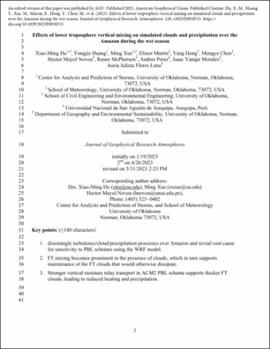| dc.contributor.author | Hu, Xiao-Ming | |
| dc.contributor.author | Huang, Yongjie | |
| dc.contributor.author | Xue, Ming | |
| dc.contributor.author | Martin, E. | |
| dc.contributor.author | Hong, Yang | |
| dc.contributor.author | Chen, Mengye | |
| dc.contributor.author | Novoa, H. M. | |
| dc.contributor.author | McPherson, R. | |
| dc.contributor.author | Perez, Andres | |
| dc.contributor.author | Morales, Isaac | |
| dc.contributor.author | Luna, Auria | |
| dc.date.accessioned | 2023-07-05T19:06:06Z | |
| dc.date.available | 2023-07-05T19:06:06Z | |
| dc.date.issued | 2023-06 | |
| dc.identifier.citation | Hu, X.-M., Huang, Y., Xue, M., Martin, E., Hong, Y., Chen, M., et al. (2023). Effects of lower troposphere vertical mixing on simulated clouds and precipitation over the Amazon during the wet season. Journal of Geophysical Research: Atmospheres, 128, e2023JD038553. https://doi.org/10.1029/2023JD038553 | en_US |
| dc.identifier.uri | https://hdl.handle.net/11244/337846 | |
| dc.description.abstract | Planetary boundary layer (PBL) schemes parameterize unresolved turbulent mixing within the PBL and free troposphere (FT). Previous studies reported that precipitation simulation over the Amazon in South America is quite sensitive to PBL schemes and the exact relationship between the turbulent mixing and precipitation processes is, however, not disentangled. In this study, regional climate simulations over the Amazon in January-February 2019 are examined at process level to understand the precipitation sensitivity to PBL scheme. The focus is on two PBL schemes, the Yonsei University (YSU) scheme, and the asymmetric convective model v2 (ACM2) scheme, which show the largest difference in the simulated precipitation. During daytime, while the FT clouds simulated by YSU dissipate, clouds simulated by ACM2 maintain because of enhanced moisture supply due to the enhanced vertical moisture relay transport process: 1) vertical mixing within PBL transports surface moisture to the PBL top, and 2) FT mixing feeds the moisture into the FT cloud deck. Due to the thick cloud deck over Amazon simulated by ACM2, surface radiative heating is reduced and consequently the convective available potential energy (CAPE) is reduced. As a result, precipitation is weaker from ACM2. Two key parameters dictating the vertical mixing are identified, p, an exponent determining boundary layer mixing and λ, a scale dictating FT mixing. Sensitivity simulations with altered p, λ, and other treatments within YSU and ACM2 confirm the precipitation sensitivity. The FT mixing in the presence of clouds appears most critical to explain the sensitivity between YSU and ACM2. | en_US |
| dc.description.sponsorship | This work was primarily supported by grant no. 20163646499 from the Universidad Nacional de San Agustín de Arequipa (UNSA) of Peru through the IREES/LASI Global Change and Human Health Institute. The first author is partially supported by the National Mesonet Program grant #10558200 and DOE ASR project (DE-SC0021159). Ming Xue was also supported by NSF grants AGS-1917701. | en_US |
| dc.language | en_US | en_US |
| dc.subject | clouds | en_US |
| dc.subject | precipitation | en_US |
| dc.subject | free troposphere vertical mixing | en_US |
| dc.subject | regional climate dynamical downscaling | en_US |
| dc.title | Effects of lower troposphere vertical mixing on simulated clouds and precipitation over the Amazon during the wet season | en_US |
| dc.type | Article | en_US |
| dc.description.peerreview | Yes | en_US |
| dc.identifier.doi | https://doi.org/10.1029/2023JD038553 | en_US |
| ou.group | College of Atmospheric and Geographic Sciences | en_US |
| dc.description.notes | An edited version of this paper was published by AGU. Published 2023, American Geophysical Union. Preprint available at https://doi.org/10.22541/essoar.167458066.61800879/v1 | en_US |
